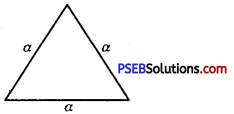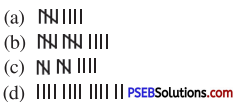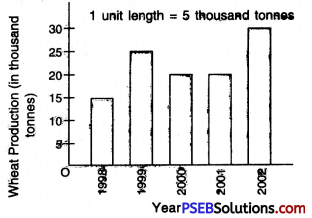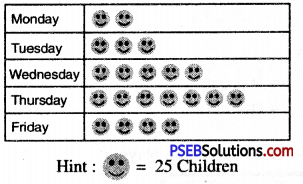Punjab State Board PSEB 6th Class Hindi Book Solutions Chapter 24 ईमानदार बालक Textbook Exercise Questions and Answers.
PSEB Solutions for Class 6 Hindi Chapter 24 ईमानदार बालक
Hindi Guide for Class 6 ईमानदार बालक Textbook Questions and Answers
भाषा-बोध
1. शब्दार्थउत्तर-पाठ के आरम्भ में दिए गए हैं।
छननी = द्रव पदार्श आदि छानने का महीन कपड़ा, छलनी
रुआँसा = रोने को होने वाला
छुट्टा = रेजगारी
भुनाना = रुपए को सिक्कों में बदलवाना
ऐंबुलेंस = घायलों एवं बीमारों को लिटाकर अस्पताल ले जाने वाली गाड़ी
दुर्लभ = कठिनाई से मिलने वाला
2. शुद्ध करके लिखें
रूपया, मजदूर, परिचीत, बजार, उत्सूक, असी, इमानदार, सूई, जलरी, पल्क।
उत्तर:
1. रूपया = रुपया
2. मजदूर = मज़दूर
3. परिचीत = परिचित
4. बजार = बाज़ार
5. उत्सूक = उत्सुक
6. असी = असि
7. इमानदार = ईमानदार
8. सूई = सुई
9. जलदी = जल्दी
10. पल्क = पलक
3. मुहावरों को वाक्यों में प्रयुक्त करो
पालक मारते ही आना = ……………… ………………………………..
गिड़गिड़ाकर ठगना = ……………….. ……………………………….
घर में ही होना = ……………………. ……………………………….
पाठ पढ़ना = …………………… …………………………………
उत्तर:
1. पलक मारते ही आना = झटपट आना-बाबू जी आप रुकिए ! मैं पलक मारते ही आया।
2. गिड़गिड़ाकर ठगना = दीनतापूर्वक प्रार्थना करके लूट लेना-महेश! तुम इनको नहीं जानते। इन्हें तो गिड़गिड़ाकर ठगने की आदत है।
3. घर में ही होना = घर की बात – तुम चिन्ता मत करो। तुम्हारे रुपए कहीं नहीं जाते। समझो कि वे घर में ही है।
4. पाठ पढ़ना = सबक लेना-सेठ ने कहा, “चलो कोई बात नहीं। समझेंगे एक रुपया देकर एक पाठ ही पढ़ा।”
![]()
4. अंतर समझो और वाक्यों में प्रयोग करो
शब्द अर्थ वाक्य
1. लौटा वापस आना, ‘लौटना’ क्रिया का भूतकाल रूप ………………………………
लोटा जल रखने का धातु का बना एक बर्तन …………………………………
2. भुनाना भूनने का काम करना ………………………………
भुनाना रुपए को सिक्कों में बदलवाना ………………………………
3. भेजा भेजना ………………………………
भेजा खोपड़ी के अंदर का गूदा, मगज …………………………..
4. दिया ‘देना’ का भूतकाल ………………………..
दिया दीपक ……………………….
उत्तर:
1. लौटा = वापस आना-मोहन कल ही दिल्ली से लौटा था।
लोटा = एक बर्तन-उसने एक लोटा पानी पिया और चल दिया।
2. भुनाना = भूनने का काम करना-वह मज़दूरनी दाना भूनने का काम करके पेट पालती थी।
भुनाना = रुपये को सिक्कों में बदलवाना-मैं ये रुपये भुना कर एक-एक रुपए के सिक्के चाहता हूँ।
3. भेजा = भेजना-मैंने उसे बाज़ार भेजा।
भेजा = दिमाग-तुम मेरा भेजा खराब मत करो।
4. दिया = ‘देना’ का भूतकाल-उसने मुझे रुपया दिया।
दिया = दीपक – घर के बाहर दिया जला कर रखना।
5. समानार्थक शब्द लिखो
माँ-बाप, सेवक, जल्दी, घर, दर्द, डॉक्टर।
उत्तर:
समानार्थक शब्द
1. माँ-बाप = जन्मदाता, मातृ-पितृ
2. सेवक = दास, नौकर
3. ग़रीब = निर्धन, दरिद्र
4. जल्दी = शीघ्र, द्रुत
5. घर = गृह, निकेत
6. दर्द = कष्ट, तकलीफ
7. डॉक्टर = चिकित्सक, वैद्य
6. अनेक शब्दों के लिए एक शब्द लिखो
जिसकी जानकारी हो चुकी हो, जहां रोगियों की चिकित्सा होती है, दवा-इलाज करने वाला, ईमान पर चलने वाला।
उत्तर:
जिसकी जानकारी हो चुकी हो : ज्ञात।
जहां रोगियों की चिकित्सा होती है : चिकित्सालय।
दवा-इलाज करने वाला : डॉक्टर।
ईमान पर चलने वाला : ईमानदार।
7. पाठ में आए अंग्रेजी शब्दों को छांटकर लिखो
उत्तर:
बटन, नोट, डॉक्टर, हैलो, एंबुलेंस।
8. निर्देशानुसार उत्तर लिखो
(क) राजकिशोर कहाँ रहते हैं ? (वाक्य को भूतकाल में बदलो)
(ख) मैं तुम्हारे साथ चलता हूँ। (वाक्य को भविष्यकाल में बदलो)
(ग) प्रताप भाई का सिर पकड़ता है। (वाक्य को भविष्यकाल में बदलो)
(घ) वे मजदूरों के नेता हैं। (वाक्य को भूतकाल में बदलो)
(ङ) वह नोट भुनाने गया है। (वाक्य को वर्तमान काल में बदलो)
उत्तर:
(क) राजकिशोर कहाँ रहते थे ?
(ख) मैं तुम्हारे साथ चलूँगा।
(ग) प्रताप भाई का सिर पकड़ेगा।
(घ) वे मजदूरों के नेता थे।
(ङ) वह नोट भुनाने जा रहा है।
विचार-बोधन
(क)
प्रश्न 1.
बसंत बाज़ार में क्या-क्या बेच रहा था ?
उत्तर:
बसंत बाज़ार में छन्नी, बटन तथा दियासलाई आदि बेच रहा था।
प्रश्न 2.
राजकिशोर ने बसंत से कोई भी सामान न खरीद पाने का क्या कारण बताया ?
उत्तर:
राजकिशोर ने बसंत से कोई भी सामान न खरीद पाने का कारण पूरे पैसे न होना बताया।
प्रश्न 3.
बसंत बार-बार राजकिशोर से कोई भी चीज़ लेने को क्यों कह रहा था ?
उत्तर:
बसंत बार-बार राजकिशोर से चीज़ खरीद लेने के लिए इसलिए कह रहा था क्योंकि सवेरे से उसका कुछ भी सामान नहीं बिका था।
![]()
प्रश्न 4.
कृष्णकुमार के अनुसार बाज़ार के हर कोने में किस तरह के लड़के मिलते हैं ?
उत्तर:
कृष्णकुमार के अनुसार बाज़ार के हर कोने में ऐसे लड़के मिलते हैं, जिनका काम गिड़गिड़ाकर लोगों को ठग लेना है।
प्रश्न 5.
बसंत का काफ़ी देर प्रतीक्षा करने पर राजकिशोर क्या सोचकर घर चल दिए ?
उत्तर:
काफी देर प्रतीक्षा करने के पश्चात् राजकिशोर यह सोच कर घर चल दिए कि चलो एक रुपया देकर यह भी एक पाठ पढ़ा।
(ख) निम्नलिखित प्रश्नों के उत्तर दीजिए
प्रश्न 1.
प्रताप राजकिशोर जी के घर क्यों गया था ?
उत्तर:
प्रताप, राजकिशोर जी के घर बसंत के रहने पर गया था। बसंत ने राजकिशोर जी को उनके पैसे लौटाने के लिए प्रताप को भेजा था।
प्रश्न 2.
राजकिशोर प्रताप के साथ उसके घर क्यों गए ?
उत्तर:
जब राजकिशोर को पता चला कि बसंत दुर्घटनाग्रस्त हो गया है और उसके दोनों पैर कुचले गए हैं तो वह उसे देखने के लिए प्रताप के साथ उसके घर गए।
प्रश्न 3.
डॉक्टर ने बसंत को देखकर क्या कहा?
उत्तर:
डॉक्टर ने बसंत को देखकर कहा कि ऐसा लगता है कि इसके एक पैर की हड्डी टूट गई है। इसे अभी अस्पताल ले जाना होगा।
प्रश्न 4.
राजकिशोर ने ऐसा क्यों कहा कि इसे बचाना ही होगा ?
उत्तर:
राजकिशोर, बसंत की ईमानदारी को देखकर बहुत खुश हुए। इसीलिए उन्होंने डॉ० से उसे हर हाल में बचाने की बात कही।
आत्म-बोध
(क)
1. ईमानदारी सबसे अच्छी नीति है-इसे जीवन में धारण करें।
2. ‘बाजार के हर कोने पर आजकल ऐसे लड़के मिलते हैं, जिनका काम गिड़गिड़ाकर लोगों को ठगना है।’ कृष्णकुमार ने बिना जाने-समझे बसंत के बारे में राजकिशोर को अपनी राय दी जो कि सर्वथा ग़लत साबित हुई। अतः किसी को जाने-समझे बिना किसी के बारे में ग़लत धारणा मत बनाएं।
कुछ करने को-स्कूल में किसी अवसर पर इस एकांकी का मंचन करें।
उत्तर:
विद्यार्थी अपने अध्यापक की सहायता से इस एकांकी का मंचन कर सकते हैं।
(ख) दिए गए शब्द संकेतों की सहायता से कहानी लिखिए और उचित शीर्षक दीजिए।
मेधावी एक सच्ची लड़की ……………. दुकान पर राशन लेने जाना, भिन्न-भिन्न सामान लेना, नौ सौ पचास रुपए का सामान लेना, मेधावी का दुकानदार को हज़ार रुपए देना ……………….. दुकानदार का मेधावी को सौ रुपए बकाया वापस करना ……. मेधावी का दुकानदार को पचास रुपए ज्यादा देने के कारण पैसे वापस करना – दुकानदार का खुश होना -धन्यवाद करना।
उत्तर:
मेधावी एक सच्ची लड़की थी। एक दिन वह राशन की दुकान पर राशन लेने के लिए गई और उसने भिन्न-भिन्न प्रकार का सामान खरीदा और उसका बिल नौ सौ पचास रुपए का बना। मेधावी ने दुकानदार को हज़ार रुपए का नोट दिया। दुकानदार ने उसे पचास रुपए लौटाने थे मगर उसने गलती से उसे सौ रुपए वापस कर दिए। मेधावी ने रुपए गिने और उसने देखा कि दुकानदार ने उसे पचास रुपए अधिक दे दिए हैं। उसने वे पचास रुपए दुकानदार को वापस लौटा दिए। दुकानदार उसकी ईमानदारी से बहुत खुश हुआ। उसने मेधावी का धन्यवाद किया और ईनाम भी दिया। शिक्षा-ईमानदारी सबसे अच्छी नीति है।
बहुवैकल्पिक प्रश्न
प्रश्न 1.
बसंत कैसा लड़का था ?
(क) गरीब
(ख) अमीर
(ग) धनी
(घ) निर्धनता
उत्तर:
(क) गरीब
![]()
प्रश्न 2.
बसंत बाजार में क्या बेच रहा था ?
(क) छन्नी
(ख) बटन
(ग) दियासलाई
(घ) ये सभी
उत्तर:
(घ) ये सभी
प्रश्न 3.
कृष्णकुमार के अनुसार बाजार में किस तरह के लड़के मिलते हैं ?
(क) धनी
(ख) गरीब
(ग) ठग
(घ) लुटेरे
उत्तर:
(ग) ठग
प्रश्न 4.
इस एकांकी से हमें क्या शिक्षा मिलती है ?
(क) ईमानदारी की
(ख) धोखेबाजी की
(ग) चोरी की
(घ) ठगी की
उत्तर:
(क) ईमानदारी की
ईमानदार बालक Summary
ईमानदार बालक पाठ का सार
बसंत नाम का एक गरीब लड़का थैले में रख कर सामान बेच रहा था। थैले में बटन, छन्नी, दियासलाई जैसे छोटे-छोटे सामान थे। उसने मज़दूर नेता राज किशोर से कुछ सामान खरीदने का आग्रह किया। वे उससे एक छन्नी लेकर नोट देते हैं। छुट्टे पैसे लेने के लिए वह गया पर काफ़ी समय तक लौट कर नहीं आया। अपने परिचित कृष्ण कुमार के कहने पर वे घर वापस चले गए कि कोई उन्हें ठग कर ले गया। काफ़ी देर बाद प्रताप नाम का एक युवक उनके घर आया। उसने उनके बचे हुए पैसे उन्हें लौटाए और बताया कि बसंत उसका भाई था जो पैसे भुना कर लाते समय एक बस के नीचे आ गया था। उसके दोनों पाँव कुचले गए। उसके माता-पिता पहले ही दंगों में मारे जा चुके थे। राजकिशोर एक डॉक्टर को ले कर उस के घर गए और उसकी ईमानदारी के विषय में डॉक्टर को बताया।
कठिन शब्दों में अर्थ:
प्रयत्न = कोशिश। दियासलाई = माचिस। छुट्टा = खुले पैसे। परिचित = जान-पहचान का। गिड़गिड़ाकर = मिन्नतें करना। भला = अच्छा। भुनाने = खुल्ले करवाने। कराहता = कष्ट न सहन करते रोना। दुर्लभ = मुश्किल से मिलने वाला।








